- How to Fix an Old Car Engine: A Comprehensive Guide
- Identifying the Problem
- Common Engine Repairs
- 1. Spark Plug Replacement
- 2. Fuel Filter Replacement
- 3. Air Filter Replacement
- 4. Valve Adjustment
- 5. Timing Belt Replacement
- Major Engine Repairs
- 1. Cylinder Head Gasket Replacement
- 2. Piston Ring Replacement
- 3. Engine Rebuild
- Tips for DIY Engine Repairs
- Conclusion
How to Fix an Old Car Engine: A Comprehensive Guide
Identifying the Problem
Diagnosing the problem with an old car engine is crucial before attempting repairs. Here are some common signs of engine issues:
- Difficulty starting the engine
- Rough idling or stalling
- Reduced power or acceleration
- Unusual noises or vibrations
- Check engine light illuminated
Using a diagnostic tool or visiting a mechanic can help pinpoint the specific problem.
Common Engine Repairs
1. Spark Plug Replacement
Spark plugs provide the ignition spark to start the engine. Worn or fouled spark plugs can cause misfires, difficulty starting, and reduced performance. Replacing them with new ones is a simple and inexpensive fix.
2. Fuel Filter Replacement
The fuel filter prevents impurities from entering the engine’s fuel system. A clogged fuel filter can restrict fuel flow, resulting in engine sputtering, poor acceleration, and even stalling.
3. Air Filter Replacement
The air filter removes dust and debris from the air entering the engine. A dirty or clogged air filter can starve the engine of oxygen, leading to reduced power, increased emissions, and decreased fuel efficiency.
4. Valve Adjustment
Valves control the flow of air and fuel into and out of the engine cylinders. Over time, valves can become misaligned or loose, causing engine performance issues. Adjusting them to the correct specifications restores engine efficiency.
5. Timing Belt Replacement
The timing belt synchronizes the movement of the crankshaft and camshaft. A broken or worn timing belt can cause catastrophic engine damage. Replacing the timing belt according to the manufacturer’s recommended intervals is crucial.
Major Engine Repairs
1. Cylinder Head Gasket Replacement
The cylinder head gasket seals the junction between the engine block and the cylinder head. A blown cylinder head gasket can leak coolant or oil, causing overheating, reduced engine power, or even complete engine failure.
2. Piston Ring Replacement
Piston rings prevent gases from leaking past the pistons in the engine cylinders. Worn or damaged piston rings can lead to reduced compression, increased oil consumption, and decreased engine performance.
3. Engine Rebuild
An engine rebuild is a major repair that involves disassembling the engine, inspecting and replacing worn or damaged components, and reassembling it to factory specifications. Engine rebuilds are typically necessary when the engine has suffered catastrophic damage or has high mileage and requires extensive repairs.
Tips for DIY Engine Repairs
While some engine repairs can be performed by experienced DIYers, major repairs should be left to qualified mechanics. Here are some tips for DIY engine repairs:
- Gather the necessary tools and materials beforehand.
- Follow the service manual or online repair guides carefully.
- Use high-quality replacement parts.
- Take your time and do the job right.
- Don’t overtighten bolts or nuts.
- Test the engine thoroughly after completing the repairs.
Conclusion
Fixing an old car engine can be a challenging but rewarding task. By following a systematic approach, identifying the problem accurately, and performing the necessary repairs, you can restore your vehicle’s engine to optimal performance. However, it’s important to seek professional help if you encounter complex or major engine issues. With proper maintenance and timely repairs, your old car can continue to provide reliable service for years to come.





